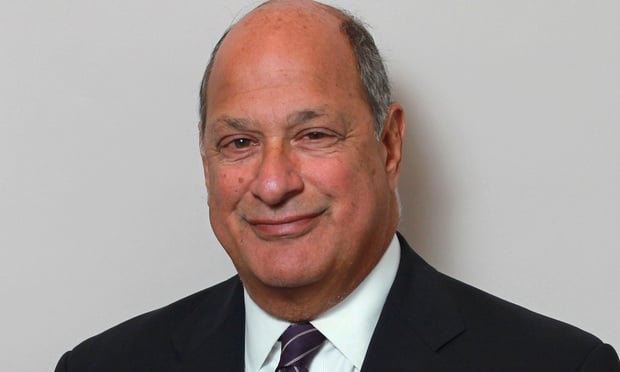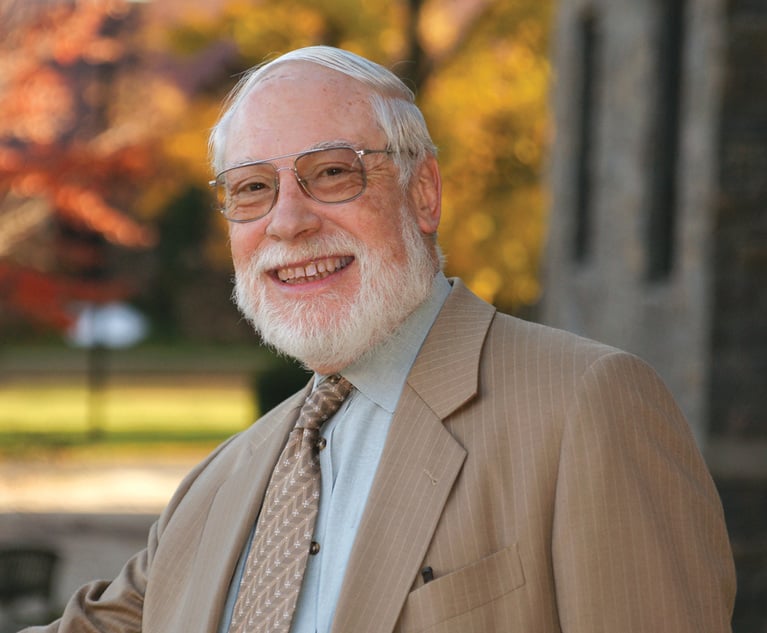When Judges Struggle With Sentencing
Virtually every judge will tell you that sentencing is the most solemn and difficult decision they must make. Some acknowledge conferring with their clerks, or occasionally with a colleague or two, simply as a gut check when confronted with a difficult sentence, or one with potentially broader ramifications than just the defendant before them. Almost every one of them, though, truly struggles with it every time.
December 14, 2018 at 11:32 AM
7 minute read
 Joel Cohen
Joel Cohen
To the non-lawyer, in particular, it might seem almost bizarre. A judge arrives on the bench, hears from both sides and immediately sentences a defendant. Yes, she did observe the trial (or sat on it non-jury) if there was a trial. Or she listened carefully to the defendant as he pleaded guilty. She has certainly studied the court-ordered probation report prepared for her consideration by the probation office. She has undoubtedly read memoranda from both the prosecutor and defense counsel. And then, on that critical day, she will finally hear oral argument from both lawyers and perhaps extremely remorseful remarks from the defendant himself. And with that, she will say, “Okay, here's my sentence.”
It seems almost surreal—a judge who, most would believe, is intended to have an open mind when she arrives on the bench to mete out a sentence, listens and, yet, immediately decides. Now, of course, the judge probably has a particular sentence in mind from which she is unlikely to be moved much when she gets on the bench. That makes complete sense. I am not suggesting that the judge's mind should be tabula rasa at that moment when the clerk emerges from chambers, says “Oyez,” and calls the courtroom to order.
Still, assume you're a defendant whose lawyer makes a passionate plea for leniency and you, credibly, are reduced to tears at that critical moment where you have an opportunity to express your remorse. Or suppose you're the prosecutor who makes a stellar presentation in a fair, but colorful, manner about the lengths to which the defendant—in your mind clearly deserving of considerable punishment—went to commit his crime. What does it mean that just two minutes later the judge has purportedly digested and weighed all that both sides have brought to the table and calculated it into the sentence she had in mind as she took the bench?
Think about if there has not been a significant pre-sentence report or substantial submissions by the parties. Or if the range of potential punishment, measured in months or years, is extremely wide. Indeed, in federal court, since the Sentencing Guidelines have been only advisory for the last 13 years, the range is indeed far wider than it used to be. From just an appearance sake, one must wonder about a judge hearing from sides and immediately lowering the sentence boom.
Now, a number of justices of the Supreme Court have publicly acknowledged that oral argument, even at that high level, rarely changes their thinking. They have read the parties' submissions and it is unlikely someone will say something new. But sentencing is not appellate argument. There is a human dynamic that must be considered. The judge—a single judge, not nine—may very well hear, for the first time, something about the defendant or his conduct. Or from the defendant himself. And that judge is deciding the fate—indeed, the very freedom, potentially for an extenuated period of time—of that defendant who is sitting in the dock watching, in real time, his life literally pass before him. Whether the judge's sentence intentions are really being altered during those white-knuckled moments while the defendant sits before him may well be beside the point.
Virtually every judge will tell you that sentencing is the most solemn and difficult decision they must make. Some acknowledge conferring with their clerks, or occasionally with a colleague or two, simply as a gut check when confronted with a difficult sentence, or one with potentially broader ramifications than just the defendant before them. Almost every one of them, though, truly struggles with it every time.
Few know that, before the Sentencing Guidelines went into effect in late 1987, uniquely the U.S. District Court in the Eastern District of New York institutionally had sentencing panels for every case—two judges, randomly selected, conferred with each sentencing judge and the representative of the probation department. While the views of the two conferring judges were not binding in any way on the judge actually imposing the sentence, there was, reportedly, somewhat of a give and take between the sentencing judge and his colleagues. Some sentencing judges, apparently, would give equal weight in their calculus to the views of their colleagues, whereas some (reportedly) would, albeit collegially, reject the others' views after hearing them. Others landed somewhere in between. Some, I had come to hear, would recommend higher sentences when they were one of the conferring judges rather than the judge with the responsibility to actually impose sentence. An understandable human and psychological dynamic—it is much easier to tell someone to send someone to jail for a long time than to actually do so.
But these panels met before the defendant appeared for sentencing, and so they could not have the benefit of any oral statements or testimony. When the Guidelines went into effect and, albeit harshly, standardized sentences so that they were no longer dependent on who the sentencing judge was, the sentencing panel program was basically disbanded. It never reappeared as a formalized practice, even though for 13 years now Sentencing Guidelines are only advisory so that, with some limitations, judges are much more free to depart from guidelines-recommended sentences. And judges continue to make these decisions on their own, and from the bench on the same day that counsel and the defendant appear for sentencing.
Not so, necessarily, however. I turn to the Dean of the federal judiciary, Senior U.S. District Judge Jack B. Weinstein—age 97, 50 years on the bench and still going strong. When he is troubled by a particular sentence, he thinks outside the box. In a recent sentence before him of a former public official—I represented the defendant—after hearing lengthy arguments from both sides and hearing from the defendant herself, Judge Weinstein said simply that he needed more time to think about the sentence he would impose given the competing arguments made to him. While Judge Weinstein said he had previously delayed sentences in this manner from time to time, any practitioner of the criminal law knows that doing so is exceedingly rare across the judiciary. Days later, he issued an order saying he had asked the Chief Judge to convene a sentencing panel, as in days of old.
I'll never know what those panelists had to say about the case—whether they recommended leniency or harshness (although the Judge made clear that the sentencing decision was his own, no one else's). And I was indeed concerned that they didn't have before them, as did Judge Weinstein himself, everything that I thought valuable from our side of the case. All I know is that the result was fair. And maybe, more important, it was pellucidly clear to me and to anyone who would have been watching that the sentencing judge had taken the time and enormous effort, because he was struggling over every aspect of the legal matter before him.
It seems to me that we want every single judge to struggle, perhaps in their own idiosyncratic way, every single time they are required to impose a sentence.
Joel Cohen, a former prosecutor, is of counsel at Stroock & Stroock & Lavan. He is an adjunct professor at Fordham Law School. Dale J. Degenshein, special counsel at Stroock, assisted in the preparation of this article.
This content has been archived. It is available through our partners, LexisNexis® and Bloomberg Law.
To view this content, please continue to their sites.
Not a Lexis Subscriber?
Subscribe Now
Not a Bloomberg Law Subscriber?
Subscribe Now
NOT FOR REPRINT
© 2025 ALM Global, LLC, All Rights Reserved. Request academic re-use from www.copyright.com. All other uses, submit a request to [email protected]. For more information visit Asset & Logo Licensing.
You Might Like
View All
Law Journal Column on Marital Residence Sales in Pending Divorces Puts 'Misplaced' Reliance on Two Cases
8 minute read

A Time for Action: Attorneys Must Answer MLK's Call to Defend Bar Associations and Stand for DEI Initiatives in 2025
5 minute readTrending Stories
- 1States Accuse Trump of Thwarting Court's Funding Restoration Order
- 2Microsoft Becomes Latest Tech Company to Face Claims of Stealing Marketing Commissions From Influencers
- 3Coral Gables Attorney Busted for Stalking Lawyer
- 4Trump's DOJ Delays Releasing Jan. 6 FBI Agents List Under Consent Order
- 5Securities Report Says That 2024 Settlements Passed a Total of $5.2B
Who Got The Work
J. Brugh Lower of Gibbons has entered an appearance for industrial equipment supplier Devco Corporation in a pending trademark infringement lawsuit. The suit, accusing the defendant of selling knock-off Graco products, was filed Dec. 18 in New Jersey District Court by Rivkin Radler on behalf of Graco Inc. and Graco Minnesota. The case, assigned to U.S. District Judge Zahid N. Quraishi, is 3:24-cv-11294, Graco Inc. et al v. Devco Corporation.
Who Got The Work
Rebecca Maller-Stein and Kent A. Yalowitz of Arnold & Porter Kaye Scholer have entered their appearances for Hanaco Venture Capital and its executives, Lior Prosor and David Frankel, in a pending securities lawsuit. The action, filed on Dec. 24 in New York Southern District Court by Zell, Aron & Co. on behalf of Goldeneye Advisors, accuses the defendants of negligently and fraudulently managing the plaintiff's $1 million investment. The case, assigned to U.S. District Judge Vernon S. Broderick, is 1:24-cv-09918, Goldeneye Advisors, LLC v. Hanaco Venture Capital, Ltd. et al.
Who Got The Work
Attorneys from A&O Shearman has stepped in as defense counsel for Toronto-Dominion Bank and other defendants in a pending securities class action. The suit, filed Dec. 11 in New York Southern District Court by Bleichmar Fonti & Auld, accuses the defendants of concealing the bank's 'pervasive' deficiencies in regards to its compliance with the Bank Secrecy Act and the quality of its anti-money laundering controls. The case, assigned to U.S. District Judge Arun Subramanian, is 1:24-cv-09445, Gonzalez v. The Toronto-Dominion Bank et al.
Who Got The Work
Crown Castle International, a Pennsylvania company providing shared communications infrastructure, has turned to Luke D. Wolf of Gordon Rees Scully Mansukhani to fend off a pending breach-of-contract lawsuit. The court action, filed Nov. 25 in Michigan Eastern District Court by Hooper Hathaway PC on behalf of The Town Residences LLC, accuses Crown Castle of failing to transfer approximately $30,000 in utility payments from T-Mobile in breach of a roof-top lease and assignment agreement. The case, assigned to U.S. District Judge Susan K. Declercq, is 2:24-cv-13131, The Town Residences LLC v. T-Mobile US, Inc. et al.
Who Got The Work
Wilfred P. Coronato and Daniel M. Schwartz of McCarter & English have stepped in as defense counsel to Electrolux Home Products Inc. in a pending product liability lawsuit. The court action, filed Nov. 26 in New York Eastern District Court by Poulos Lopiccolo PC and Nagel Rice LLP on behalf of David Stern, alleges that the defendant's refrigerators’ drawers and shelving repeatedly break and fall apart within months after purchase. The case, assigned to U.S. District Judge Joan M. Azrack, is 2:24-cv-08204, Stern v. Electrolux Home Products, Inc.
Featured Firms
Law Offices of Gary Martin Hays & Associates, P.C.
(470) 294-1674
Law Offices of Mark E. Salomone
(857) 444-6468
Smith & Hassler
(713) 739-1250







